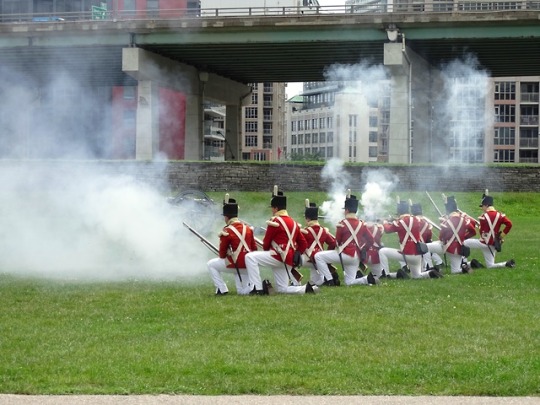#musketemen
Photo










Fort York National Historic Site of Canada, Toronto (No. 6)
The Canadian Regiment of Fencible Infantry, commonly known as the Canadian Regiment or the Canadian Fencibles, saw service in Upper and Lower Canada during the early 19th century, notably during the Anglo-American War of 1812.
The regiment was originally raised in Scotland amongst highlanders keen on emigrating to Canada in 1803-4. The unit was to see service only in British North America. However, misunderstandings regarding the terms of enlistment and rumours that the regiment would be sent to India caused the recruits to mutiny in Glasgow. In response, the men were all discharged in the fall of 1804. Subsequently, the commissioned officers and a skeleton crew of other ranks were sent to re-raise the regiment in the Canadas.
Initially, the commissioned and non-commissioned officers were Scottish while the core of the regiment would be French and English-speaking Canadians. The Scottish roots of the regiment are evident in the regiment's coat of arms with a thistle. The regiment was created in Montreal in 1803, but did not begin recruitment until 1805.
By the start of the War of 1812, the regiment's strength was at 600 men.
The Canadian Fencibles first received scholarly attention when Scottish popular historian John Prebble featured the regiment's 1804 mutiny in his 1975 book Mutiny: Highland Regiments in Revolt. Canadian historian Robert Henderson also explored the history of the unit in a series of articles, several of which appeared in Military Illustrated in 1991. Most recently, Eamonn O'Keeffe authored a book chapter on the regiment's fife and drum corps and band. In an article for Canadian Military History, O'Keeffe also shed light on the inner workings of the regiment through analysis of the court martial of Canadian Fencibles Lieutenant John de Hertel, who was tried for assaulting a fellow officer in Fort York's Blue Barracks in 1815.
Châteauguay (1813)
Crysler's Farm (1813)
Lacolle Mills (1814)
The Canadian Regiment was disbanded in July and August 1816 at Kingston and Montreal. The history and heritage of the regiment, together with its Battle Honours for Châteauguay and Crysler's Farm, are commemorated within the Canadian Army by the Royal 22e Régiment.
It was recreated in 1984 as a military re-enactment unit, continuing to this day with both military and civilian displays, across Canada and the United States. Participating in recreated battles, youth events and festivals across the country, the group's membership continues to grow with new elements, such as civilian portrayals, artillery and naval elements, being added and expanded, regularly.
The Friends of Fort York now hire students to recreate the regiment at Fort York in Toronto, Ontario during the summer months. This group is known as the Fort York Guard. At the Scout Brigade of Fort George each September, the sub-camp for youth of the Cub Scout program also recreate the regiment.
Source: Wikipedia
#Fort York National Historic Site of Canada#Fort York National Historic Site#travel#Fort York Heritage Conservation District#Old Fort York#Toronto#Ontario#Canada#original photography#summer 2018#vacation#Fort York Guard#historical reenactment#Uniform of Canadian Regiment of Fencible Infantry#musketemen#military re-enactment unit#Brown Bess musket#landmark#tourist attraction#Gardiner Expressway#cannon#architecture#demonstration
1 note
·
View note